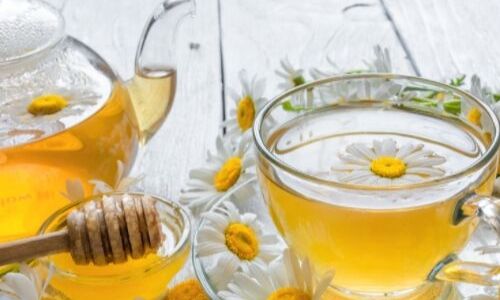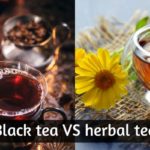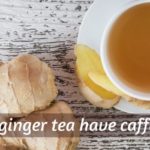Chamomile tea is one of those herbal teas that manages to soothe anyone, anytime. There's something very delicate and relaxing about it, and I think many of us are well acquainted with it.
So I decided to make this chamomile tea guide, to answer any questions anyone might have about this wonderful herbal brew. And how to make a cup of chamomile tea at home as well.
Table of Contents
What is chamomile tea ?
Chamomile tea is the brew made from chamomile flowers. This is done by adding hot water to a certain amount of dried chamomile flowers, and allowing it to steep for about 5 minutes.
The resulting brew (tisane) is a very relaxing and soothing drink, very often the base for a bedtime tea, or stress management teas.
Chamomile is a medicinal plant, and has been known for its health benefits for ages, especially for its calming and muscle relaxing properties.
The chamomile itself looks a lot like a daisy, with a long, thin stem and leaves, a fairly large yellow center, and white, long petals. It has a strong balmy, earthy smell.
As it is a herbal tea, it contains no caffeine, and this again makes it a good tea for those who need a little peace and quiet in their lives before turning in for the night.
You'll be able to find chamomile tea in one form or another in nearly any grocery or health food store.
Where does chamomile grow ?
Chamomile is native to Europe but very quickly spread to North America, and is now a very common plant, even in the wild. So if you're looking to know where your chamomile tea is sourced from, know that it could be from anywhere, even your own country.
Most of the time the producer should have a label on the back of the tea bag or box, stating the origin of the herb.
What is chamomile tea made of ?
Chamomile tea is made of the flowers of the chamomile plant. This is true for nearly all herbal teas, as using fresh flowers would result in an unwanted aroma in the infusion.
Using dried flowers also concentrates the flavor of the chamomile flowers, and as such lets you have a more enjoyable experience.
If you have a pollen allergy, you might be advised to stay away from chamomile tea since the pollen is used in making this tea as well. It's naturally found on the yellow flower head.
You may also find parts of the stem among the dried flowers, since it's so well connected to the flower itself. A small amount of stem is alright to brew with.
How to make chamomile tea
Making chamomile tea is simple enough, though it depends on how strong you want your tea. And there is a difference between using tea bags and loose leaf tea.
Most of the time tea bags will contain only small amounts of the flower, and several other filler teas to make up the bulk of the tea. With loose leaf tea you get the full experience.
However, a tea bag will usually provide a more varied experience and comes in many different flavors. It's up to you what you'd like to do. I'll give you the recipe for both versions.
So for one cup (8 oz/236 ml) of brewed chamomile tea, you'll need:
- 8 oz of hot water if using tea bag, 9 oz if using loose herbs
- water temp should be 90 C/194 F
- 2 teabags, or two heaping teaspoons of dried chamomile flowers
- filter or strainer or tea ball (if not using teabags)
- one tea cup or mug to hold the tea
- one pot or kettle to boil the water
A word on how much water to use. When using a teabag, some water will be absorbed into the ingredients inside the bag, but not very much. This is why using exactly 8 oz of water will leave you with almost as much brewed tea.
However if you use loose dried flowers to make chamomile tea, they will absorb more water, which is why you need to allow for the extra ounce of water.
This way you'll get 8 actual oz/236 ml of brewed tea. If you were to use 8, you'd end up with about 7, which might make too strong a tea.
So, start by bringing your water to a boil. Always boil on the stove or with an electric kettle, but do not use a microwave. This is because microwaving often makes for unevenly heated water (cold and hot pockets), and may result in sudden bursts of water.
It's also easier to judge the temperature of your water by looking at it when you actively boil it.
Once your water has boiled, turn the heat off, and let it stand for 2 minutes. This ensures that you've brought it down to 90 C/194 F. If you were to use water too hot, like actively boiling water, you'd scald the tea and this would result in a bad tea.
Whether you use dried flowers or tea bags let the tea steep for 5 minutes. Chamomile tea won't get bitter like true teas if you let it steep for too long, but it can develop a slightly sticky texture if it's too concentrated.
Once your tea's done steeping, remove the tea bags or tea ball or whatever filer you've used. Or, strain the tea is you're using a strainer.
The best method to do this, from what I've noticed, is to actually steep the tea in the cup you'll be drinking from. This is best done with a tea cup or mug that's already got a filter included, and you only remove it when you're done steeping.
This tea mug from Sweese is pretty much the best thing ever when it comes to brewing a single serving of chamomile tea, even if you'd like to drink more than 8 oz in one go.
It's a large mug, it can fit up to 15 oz/440 ml of drink. But, when you're brewing you'll have to allow some room for the filter and how full it will be.
This is a porcelain cup, comes with a stainless steel filter, and a porcelain lid to keep your drink hot, and it can also double as a coaster or trivet to hold the filter once you're done steeping.
You can find the listing on Amazon here, and read the reviews here.
How to drink chamomile tea
Now that you've made your cup of chamomile tea, let's discuss how to drink it. By this I mean how often, or how much tea in one sitting, and even what to mix it with.
Chamomile tea is a mild sedative, so I would advise against drinking too much of it. Limiting yourself to about 3 cups a day (so about 24 oz/700 ml) should be safe, since by this amount it can help you relax without producing side effects.
As for when to drink chamomile tea, that depends on you and what you need it for, If you're trying to fall asleep and have an easier time battling insomnia, then you will need to drink it about half an hour before bed.
I would say maybe another cup 203 hours before bed, if you really need to relax and think you need tome extra help.
If you're just trying to unwind in the middle of the day, like maybe you have a 3 hour window, then one cup at the beginning of your break will definitely help. No more than that though, if you're going to need to be very focused and have a sharp mind once your break is over.
What does chamomile tea taste like ?
Chamomile tastes kind of balmy, definitely flowery but not on the light side. It's a deeper, darker tasting tea and it's a bit close to watered down honey, minus the sweetness.
You get some definite pollen notes, but mostly soothing earthy tones.
The best way to describe chamomile would be to try it yourself. I say this because it's a hit or miss kind of flavor, producing strong 'ugh' or 'yes please !' reactions from people. There isn't really anyone who's kind of meh about chamomile tea.
Seeing as chamomile is so easy to get a hold of, I recommend you give it a shot and make a cup at home. you can take a look at this one by Celestial Seasonings.
It's a six pack deal, and if this is your first time drinking chamomile tea then I' sure you'll be very pleased both with the flavor and the scent of this tea.
Normally one teabag is good for 200 ml/6.7 oz of water, but I recommend you try and use two for 9 oz, to get a stronger tea. That's just me though, maybe you don't like your tea as strong.
You can find the listing on Amazon for this tea here, and read the reviews as well.
Can you have chamomile tea with milk or honey ?
I grew up with pure chamomile tea, that is just chamomile and a lump of sugar, that's it. So for me, that's the best version since I have some very fond memories of drinking it in the evening while reading in high school.
But, I have heard of people adding a little bit of milk tot heir chamomile tea and having it taste great, so I wouldn't be surprised to find it in your cup as well.
Just remember to add a small amount, otherwise it will overpower your tea. A more in-depth discussion of the best milks to add in tea is here.
You can always use powdered creamer in your tea as well, especially if it's something plant based since those seem to dissolve the best.
AS for honey, you can totally add honey on your chamomile tea, as well as honeycomb. Both will provide your tea with an extra layer of flavor, making the already flavorful chamomile richer, a bit earthier but also sweeter.
In terms of flavor chamomile and honey go very well together, same as honey and lavender, or honey and vanilla.
Honey vanilla chamomile tea to relax
Since we're discussing various ways to flavor chamomile tea, let's talk about a very famous chamomile tea that's going to taste great if you're looking to get a different flavor.
This tea by Celestial Seasonings is based on chamomile, honey, and vanilla, with a few other herbs and spices added.
Total ingredient count is (from the product owner's Amazon page): Chamomile, Orange Peel, Natural Honey, Vanilla Flavor with Other Natural Flavors, Licorice, Roasted Chicory, and Lemon Grass.
It comes as a 6-pack offer, and each pack has 2 teabags. So you're essentially getting 120 teabags, which is a fairly large amount of tea. But if you're drinking 2-3 cups of chamomile tea per day, you'd go through it in about 30-40 days.
This chamomile tea is famous for being especially flavorful, and a really wonderful drink to have in the evening, as it's both soothing and naturally caffeine free.
You can find the listing for this tea on Amazon here, and read the reviews as well.
Chamomile tea effects on health
Chamomile tea is famous for several health benefits, and I'll get into them right here. Some might be obvious and you might've heard about them already, but they all deserve an explanation of their own.
Chamomile tea reduces inflammations and skin conditions or lesions
Reducing inflammation is one of its best benefits, as it's been used as a muscle relaxant and relief for angry, red lesions or inflammations over the centuries.
This is because the anti inflammatory properties also come along with a range of antiseptic effects, which again helps reduce redness and irritation.
Chamomile tea is a very widely used plant in various salves meant to rebuild and soothe the skin after minor to mild trauma, like skid marks on children, minor cuts, scratches.
In the case of tinctures chamomile also helps clean and immediately reduce inflammation in acne scars (the type that does come to a head and eventually pops).
In case if minor burns, chamomile tea is recommended as well. Leaving a brewed chamomile tea bag to sit on the burn (as long as it's not severe) will help soothe the skin. You should not use hot tea bags, but rather lukewarm or cold ones.
Chamomile tea is good for managing blood sugar levels
It seems chamomile tea has an effect on people suffering from diabetes, in that it may help reduce blood sugar levels. Various tests done on human subjects (as in people drinking the tea vs those not drinking it) came to the conclusion that chamomile tea does have an positive impact.
There is another upside to this, since chamomile is anti inflammatory it can help reduce damage and inflammation of the pancreatic cells, which is something that happens when blood sugar is routinely elevated to high measures, for long periods of time.
Even studies done on rats seem to show that routinely drinking chamomile tea helps with lowering blood sugar, in time.
While chamomile tea is not a complete treatment for high blood sugar or diabetes, it's something you can use to help keep things under control, along with medication.
Chamomile tea promotes relaxation and relieves anxiety
Time and time again chamomile tea has been effectively used to reduce stress and anxiety in people who tend to encounter it often, either at work or at home.
This is largely due to the natural effect chamomile has on the body, effectively helping the muscles relax. This helps in several ways.
First, anxiety and stress levels are lowered when the body feels less tense and chamomile definitely helps relieve tension. This is why you'll very often see chamomile as one of the main ingredients in bedtime teas or relaxation teas.
Second, relaxed muscles will also help with digestion, which is another important factor that influences stress and/or trouble falling asleep.
This means that drinking chamomile tea before bed will help with indigestion and possibly even constipation, as that too can be triggered by excessive tension in the body.
All of this leads to a relaxed, zen body, which in turn leads to a relaxed state of mind, which is what many people are after, so they can have an easier time falling asleep.
Chamomile tea may help with reducing menstrual pains
Since chamomile tea helps with relaxing the muscles, another topic it can help with is reducing the severity of menstrual cramps. This is because menstrual cramps are the uterus actually contracting, as it sheds its lining.
Making these contractions less powerful, and thus less painful, may help many women who suffer from excessive PMS. That does not mean the contractions will not happen anymore, just that they're less aggressive.
And, in some cases where there is ovulation pain, chamomile tea may help too, as it decreases inflammation and may help in this respect as well.
Drinking chamomile tea during pregnancy
Exactly because of the muscle relaxing properties of chamomile tea, drinking this tea during pregnancy might not be a good idea.
Now, one cup every few days may not do much harm (or none at all), since you need several cups a day, for several weeks or months to get the full health benefits.
But drinking chamomile tea regularly during pregnancy may increase the risk of miscarriage, especially in the first trimester. This is because the chamomile can make the uterus relax more than it should, thus possibly triggering a miscarriage.
Some women may be very sensitive to chamomile, and for them it might be best to completely avoid chamomile. This is especially true for women who have already had a miscarriage. No reason to risk it gain.
Does chamomile tea have caffeine ?
Chamomile tea has no caffeine whatsoever. In fact, it does pretty much the opposite of caffeine.
Where caffeine would wake you up, make you focused, alert, and sharpen your reflexes chamomile does the opposite. Chamomile is going to help you relax, soothing the mind in the process.
So no, chamomile has no caffeine at all. The only way it could have caffeine is if it's combined with another tea that contains caffeine (like green, black, white, Pu'erh or oolong), or it was added separately.
This is because chamomile is a herb (a flower, actually) that does not naturally contain caffeine, at all.
Does chamomile tea make you sleepy ?
Yes, chamomile does make you sleepy. It's often found as a main ingredient in bedtime teas, and it a very soothing and relaxing herbal tea. This means it will help you de-stress, reduce anxiety (even if just for a few hours), and relieve tension in the body.
If you're planning on drinking chamomile tea before bed, go ahead. I would recommend brewing a double cup before bed, or drinking two cups one before bed, and one 2-3 hours before bed, to get the maximum effect.
Conclusion
Drinking chamomile tea seems to be a human habit since we first discovered the properties of this plant. Chamomile is versatile and helpful in many ways, actually being recognized as a medicinal plant.
Making tea from it means you're also going to get some health benefits, along with the flavors, and you need to be careful to not overdo it.
If you want to know more about coffee or tea, feel free to check the related articles below. Who knows what else you might find ?












